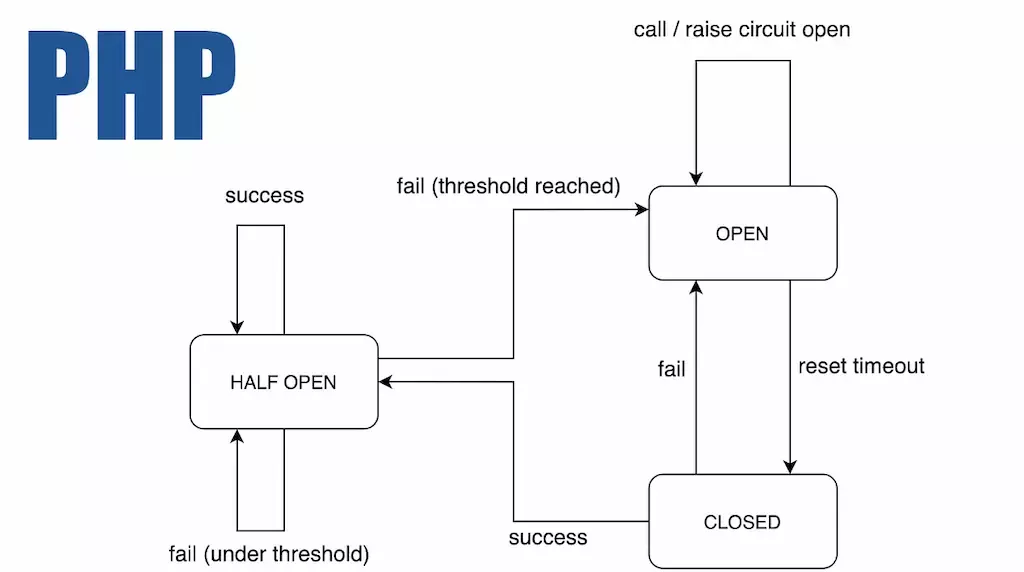
Circuit Breaker pattern in php

The Circuit Breaker pattern is a design pattern used in software development to enhance the stability and resilience of a system
The Circuit Breaker pattern is a design pattern used in software development to enhance the stability and resilience of a system by preventing it from repeatedly making calls to a service or component that is likely to fail. This pattern is particularly useful in distributed systems and microservices architectures. It helps to protect your application from cascading failures due to repeatedly calling a failing service.
The Circuit Breaker pattern is a powerful tool for improving the resilience and stability of distributed systems and microservices architectures. It’s especially useful when dealing with services or components that are prone to failures. Let’s explore some common use cases, pros, and cons of the Circuit Breaker pattern.
Use Cases:
- Microservices Architecture: In a microservices environment, one failing service can potentially affect other services that depend on it. The Circuit Breaker pattern helps prevent cascading failures and isolates the impact of a failing service.
- External Dependencies: When your application relies on external services or APIs, the Circuit Breaker pattern can protect your application from slowdowns or outages caused by those external services.
- Throttling and Rate Limiting: The pattern can be used to enforce rate limiting and avoid overwhelming downstream services with too many requests in a short time.
- Resource-Intensive Operations: If your application performs resource-intensive operations that could cause bottlenecks or slow down the system, the Circuit Breaker pattern can prevent these operations from bringing down the whole system.
Pros:
- Resilience: The Circuit Breaker pattern enhances the resilience of a system by preventing repeated attempts to access a failing service, thus avoiding cascading failures.
- Fail Fast: The pattern allows your application to fail fast and handle failures gracefully instead of waiting for long timeouts or causing delays.
- Reduced Load: When the circuit is open, requests are not sent to the failing service, reducing the load on the service and potentially allowing it to recover faster.
- Improved User Experience: The pattern helps maintain a better user experience by avoiding long response times or error messages due to failing services.
- Automated Recovery: The pattern can automatically transition the circuit from an open state to a half-open state after a timeout, allowing the system to check if the service has recovered before fully re-enabling it.
Cons:
- Overhead: Implementing the Circuit Breaker pattern introduces some complexity, which might lead to additional code and maintenance overhead.
- False Positives: In some cases, the circuit might open prematurely due to temporary issues, causing requests to be blocked even when the service could handle them.
- Complexity: Implementing a robust Circuit Breaker mechanism requires careful consideration of factors such as timeouts, reset strategies, and handling edge cases.
- Configuration Challenges: Determining appropriate thresholds, timeouts, and retry strategies can be challenging and might require tuning for different services or scenarios.
- Not a Silver Bullet: The Circuit Breaker pattern is not a replacement for proper application and system design. It should be used in conjunction with other strategies for handling failures.
In PHP, you can implement the Circuit Breaker pattern using a combination of classes and strategies. Here’s a simplified example of how you could implement a Circuit Breaker pattern in PHP:
class CircuitBreaker {
private $state = 'closed';
private $failureThreshold = 3;
private $resetTimeout = 300;// 5 minutes in seconds
private $failureCount = 0;
private $lastFailureTime = null;
public function execute(callable $operation) {
if ($this->state === 'open' && $this->isTimeoutReached()) {
$this->state = 'half-open';
}
if ($this->state === 'closed' || $this->state === 'half-open') {
try {
$result = $operation();
$this->reset();
return $result;
} catch (Exception $e) {
$this->handleFailure();
throw $e;
}
}
throw new CircuitBreakerOpenException("Circuit breaker is open");
}
private function handleFailure() {
$this->failureCount++;
$this->lastFailureTime = time();
if ($this->failureCount >= $this->failureThreshold) {
$this->state = 'open';
}
}
private function isTimeoutReached() {
return time() - $this->lastFailureTime >= $this->resetTimeout;
}
private function reset() {
$this->failureCount = 0;
$this->lastFailureTime = null;
$this->state = 'closed';
}
}
class CircuitBreakerOpenException extends Exception {}
// Usage
$circuitBreaker = new CircuitBreaker();
try {
$result = $circuitBreaker->execute(function () {
// Call the service or perform an operation here
// For example, making an HTTP request or accessing a resource
// return $response;
});
echo $result;
} catch (CircuitBreakerOpenException $e) {
echo "Circuit breaker is open, please try again later.";
} catch (Exception $e) {
echo "An error occurred: " . $e->getMessage();
}
In this example, the CircuitBreaker class
manages the state of the circuit breaker and determines whether to allow an operation to proceed or throw an
exception based on the circuit's state. The circuit can be in one of three states: "closed," "open," or "half-open."
Please note that this example provides a simplified implementation of the Circuit Breaker pattern. In a real-world scenario, you might need to handle more complex situations and integrate the pattern into your application’s architecture.
In summary, the Circuit Breaker pattern is a valuable tool for enhancing system reliability and stability, especially in distributed and microservices architectures. It offers significant benefits in preventing cascading failures and improving overall application resilience. However, it should be used judiciously and configured carefully to avoid false positives and other potential drawbacks.

